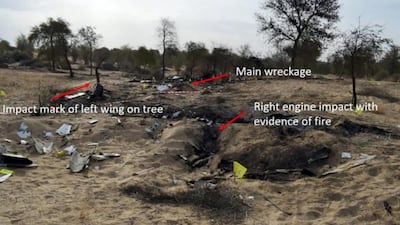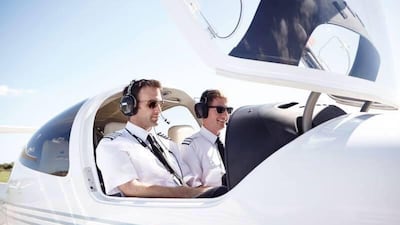Investigators probing a plane crash near Dubai Airport which killed all four people on board have said there will be stricter rules to lessen the risk of a repeat accident.
Experts believe the small Diamond DA62 aircraft crashed on May 16 because it had followed too closely behind a far larger Airbus passenger jet.
A Thai Airways aircraft was approaching a parallel runway at the time of the tragedy, with the resulting turbulence causing a loss of control in the smaller plane.
Three British men and one South African died after the aircraft turned upside-down in the air and smashed into a nature reserve near Mushrif Park about 6km from the runway. The aircraft's seats were found 50 to 68 metres away from the main wreckage.
In a preliminary report, issued by the Air Accident Investigation Sector of the UAE General Civil Aviation Authority on Sunday, investigators called for new warnings to be issued to air traffic controllers and light aircraft pilots about the dangers of so-called ‘wake turbulence’ and the importance of maintaining safe distances.
"Observations of previous approaches during the same calibration flight indicated that the DA62 consistently followed preceding traffic on approach to the parallel runway at distances which were below the specified minimum separation," the report said.
"The radar monitor recording indicated that there was an air traffic control inconsistency in advising the DA62 of the expected occurrence of hazards caused by wake turbulence from traffic."
Tighter rules are also being put in place in the UAE to ensure stricter regulations cover all flights following the crash.
The DA62 was carrying out lighting checks at the airport, as part of an upgrade programme, and it was found that these operations were not necessarily covered by existing guidelines.
"A safety decision is being prepared to ensure standardised procedures are developed, implemented and maintained for the management of unusual or abnormal aircraft operations, including calibration flights, as it was found that regulations, standards and recommended practices and procedures did not specifically cover the management of such operations", the report said.
Two of the three UK nationals were named as former RAF wing commander David Phillips and William Blackburn, a first officer at Flight Calibration Services, the Sussex-based owner of the plane. The pair had more than 4,000 flying hours between them.
Christopher Stone was the third Briton to die, while South African Fritz Venter, a married father-of-one, was also a victim.
The twin-engine aircraft usually has a total of seven seats, although the aircraft that crashed in Dubai had just five, with other space taken up by runway calibration equipment. It was built just 18-months before the tragedy.
On the day of the crash, it had flown nine circuits of the airport performing lighting checks, crashing on its tenth approach, at around 7.30pm. It was completely destroyed by the impact and a subsequent fire.
The plane carried no voice recorder or flight data recorder, known colloquially as "black boxes," as it was not required to do so because of its small size. A more detailed report into the accident is expected to be released at a later date.
Dubai’s last major aircraft incident happened on August 3, 2016. An Emirates Boeing 777-300 coming from Thiruvananthapuram, India, crash landed, but no lives were lost among its 300 passengers and crew. A firefighter was killed in a subsequent explosion.





